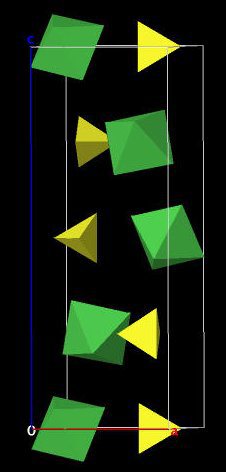Crystals you can grow at home – Nickel Sulphate Hexahydrate
What does it look like?

Spot the helix! Drawn using Jmol.
What is it?
Nickel sulphate hexahydrate (NiSO4.6H2O) forms large, perfect crystals that can easily be grown at home – just dissolve plenty of NiSO4 in water and let the water evaporate. You can see a beautiful example here. As an extra bonus, by choosing the appropriate temperature you can get slightly different coloured crystals – up to 53 °C the crystals will be dark blue-green, and above 53 °C they will be clear green. These colours correspond to slightly different structures, and this is an apparently unique situation, as similar sulphate compounds are only stable as a single structure type. As might be expected for something so easily grown, it is found in nature as the mineral retgersite.
NiSO4.6H2O is also interesting because of its ability to rotate the direction of polarisation of light – and the strength of this rotation depends on the wavelength of the light, even switching rotation direction at 0.5 μm. In a fascinating paper, Stadnicka, Glazer and Koralewski [1] were able to relate the direction and strength of the optical rotation to the properties of the structural helix formed by the O atoms. The helix goes from top to bottom on the structural diagram above.
Where did the structure come from?
The structure of the lower-temperature phase was first determined in 1932 by Beevers and Lipson [2]. It was sufficient to classify X-ray reflections into 8 intensity classes ranging from "very strong" to "absent" in order to derive and verify their model. Both forms have since been extensively studied by X-ray and neutron diffraction.
[1] Stadnicka, K., Glazer, A.M. and Koralewski, M. (1987), Acta Cryst. B43, 319-325 http://dx.doi.org/10.1107/S0108768187097787
[2] Beevers, C. A. and Lipson, H. (1932) Z. Kristallogr. 83, 123-135 (http://rruff.info/doclib/zk/vol83/ZK83_123.pdf)
Further reading
Angel, R. J. and Finger, L. W. (1988) “Polymorphism of Nickel Sulfate Hexahydrate”, Acta Cryst. C44, 1869-1873 http://dx.doi.org/10.1107/S0108270188006717






